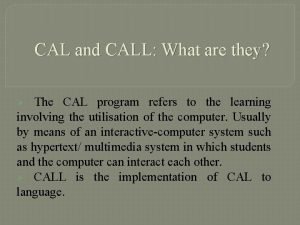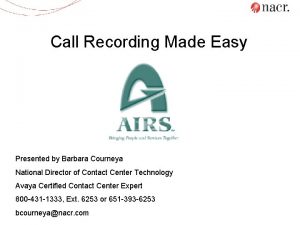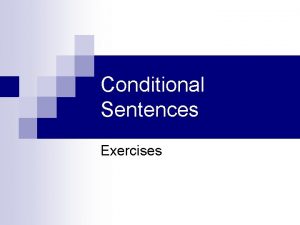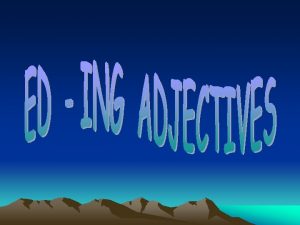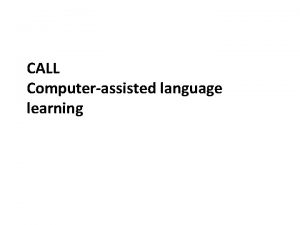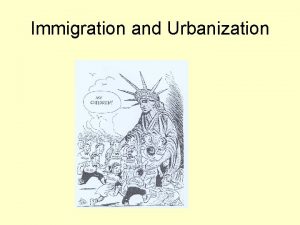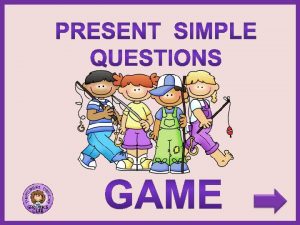CAL and CALL What are they The CAL
















- Slides: 16

CAL and CALL: What are they? The CAL program refers to the learning involving the utilisation of the computer. Usually by means of an interactive-computer system such as hypertext/ multimedia system in which students and the computer can interact each other. Ø CALL is the implementation of CAL to language. Ø

CALL: Underlying Considerations The considerations which reflect the use of computers in language learning are utilised in the computer’s unique features such as: 1. The computer’s flexibility. 2. The ability to interact with learners. 3. Giving individual attention to students. 4. Having the potential to enhance the development of comunicative competence in a second language. 5. Offering many advantages for individual instruction. 6. Having great potential as a state of the art technology for language learning.

Advantages and Disadvantages of CALL � 1. 2. 3. 4. Advantages CALL encourages users (students) to develop a non-sequential reading habit, which will carry over to reading tasks with traditional, printed material CALLS offers freedom for users to choose any topic of information available within the package CALL can motivate the users (students) to be able to collaborate very usefully in problem solving which in itself is considered to be a good skill to acquire, as it can be implemented in wide range of different context CALL allows the student to determine what particular topics and how long he wants to learn because of it’s time flexibility

� Disadvantages 1. 2. 3. Less handy because CALL carries computer to be used In the reading text, it is more difficult and tiring Costly enough for programmer or teacher because they have to provide to purchase equipment, design programs, and for the maintenance

Students’ view towards CALL program � 1. 2. Study 1 In terms of using the system 85% students/respondents stated that the system was very easy to use 10% students/respondents stated that the system was fairly easy to use 5% students/respondents stated that the system was is straightforward In terms of system performance 90% students/respondents stated that the program was very interesting 5% students/respondents stated that the program was fairly interesting 5% students/respondents stated that the program was at average interest

3. 4. � In terms of structure of the CALL tutorial program 75% students/respondents stated that the structure was excellent 20% students/respondents stated that the structure was good 5% students/respondents stated that the structure was O. K In terms of the content of the system 85% students/respondents stated that the content was very clear or helpful 5% students/respondents stated that the content was fairly clear 10% students/respondents stated that the content was valued average In conclusion, we can say that the use of system is very easy, the performance of presentation is very interesting, the content is very clear and helpful, and the structure of the system is excellent. So, the whole system is good.

� 1. 2. 3. 4. Study 2 The material covered in the system should be added so that users can learn more aspects of English There should be direct access from the index section to a particular point The layout of the screen should be balance between the right and left side The additional information or explanations included in the glossary should be increased

What is Web-based Learning? The concept of web-based learning comprises many practical applications of computer and internet in developing, administering, and conducting learning activity such as the use of internet as the source of material, online course, online assignment and test.

Web-based learning is one way to learn, using web-based technologies or tools in a learning process. In other words, learner uses mainly computers to interact with the teacher, other students and learning material. Web-based learning consists of technology that supports traditional classroom training and online learning environments. It can take the form of: (1) a pure online learning in which the curriculum and learning are implemented online without face-to-face meeting between the instructor and the students (2) a hybrid in which the instructor meets the students half of the time online and half of the time in the classroom, depending on the needs and requirement of the curriculum.

History of Web-based Learning 1. Around 1950 s : The development of basic classroom instruction into computer-based instruction with the emergence of instructional television. 2. In the 1960 s and early 1970 s : the instructional television changed into audio tutorial system, personalized systems of instruction, and other forms of programmed tutoring.

3. Around 1980 s : The development reached an important point with the introduction of computer-based instruction. 4. At the beginning of 1990 s : People began to implement webbased technologies especially in higher education. Such technologies have captured most scholars’, researchers’ and educator’s attention both for its advantages and disadvantages. 5. Now : it is become not only a trend but also a challenge for colleges and universities to develop an online education or at least make it a pat of the classroom instruction.

Current Application of web-based Instruction Educational institutions, private industry, the government, and the military institutions currently show a continuous growing use of web-based instruction. In education area, teachers may use webbased instruction to support their teaching. They developed web-based English language teaching to enable students to get an access to learning material anytime.

The Advantages of Web-based Learning Kruse (2004) elaborates that web-based learning generates a lot of advantages such as �Access availability at anytime and anywhere around the globe. �An affordable equipment cost per-student. �Better tracking, assessing and recording students’ presence and achievement. �More personalised learning and material support. �Easily updated content.

Disadvantages of Web-based Learning Unesco (2009) and Kateri (2009) reported that � Web based learning still lack of interaction among students and between students and lecturer. � The lack of multimedia in many WBT programs, which is due to the limitation of bandwidth. � The lack of pressure from deadlines. � Little support with difficulties especially regarding fees, buying books or scheduling exams. � Difficulties in integrating studies as a subtantial part into real life. � Prejudices against and doubts about the quality of distance or web-based learning.

Roles of the web in instructional settings Web-based instruction is capable of providing direct instruction to meet individual learning objectives. The web, as a potential medium for both distance learning and teaching, provide an inherent flexibility, which allows application in a variety of ways within an educational context.

Kahn (2001) explained two different levels of web-based learning use �Micro use, which means the use of the web as a way to supplement or enhance conventional classroom instruction �Macro use, which refers to complete distance learning programs and virtual universities.
 Mikael ferm
Mikael ferm Cal and cal
Cal and cal Protective put strategy
Protective put strategy Option terminology
Option terminology Qfiniti call recording
Qfiniti call recording They shall rise up and call her blessed
They shall rise up and call her blessed Why is nyc called the big apple
Why is nyc called the big apple They call me a brainless tory
They call me a brainless tory Rankings: what are they and do they matter?
Rankings: what are they and do they matter? Conditional sentences exercises
Conditional sentences exercises We seek him here we seek him there
We seek him here we seek him there It is not you they have rejected but me
It is not you they have rejected but me Jordan 14
Jordan 14 Grammar rules frustrate me they're not logical they are so
Grammar rules frustrate me they're not logical they are so For they not know what they do
For they not know what they do Knowledge not shared is wasted
Knowledge not shared is wasted Hát kết hợp bộ gõ cơ thể
Hát kết hợp bộ gõ cơ thể

